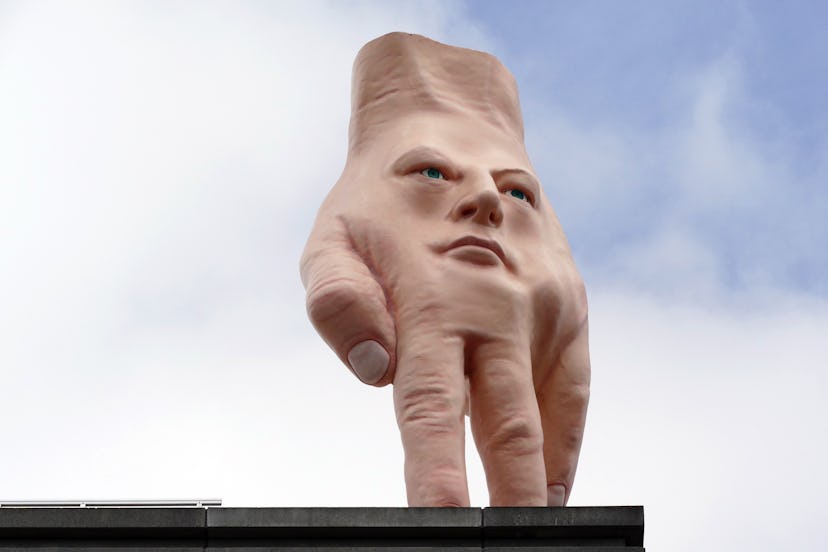Meet Quasi, a Giant Hand Who Means Well But is Terrifying Local New Zealand Townsfolk
Named after the Hunchback of Notre Dame, but perhaps more of Frankenstein's Monster.

He stands high above them on a rooftop overlooking a city square. He is meant for good and to bring joy and comfort to the townsfolk below after tragedy. Though, many of those residents have grown to fear and deplore him. They decry his existence on social media. They describe him as fuel for their worst nightmares, and demand his haste banishment from public view. He is Quasi, a giant sculpture of a hand fashioned with a human face, and while he may be one of the most controversial things in the island nation of New Zealand, but for the moment he still stands tall and proud.
Quasi is monumental in size. Nearly sixteen-and-a-half feet tall. There are no surrounding for him to shrink into should he feel shy or insulted. No eyes set in his direction could casually glance past him. His existence was designed for attention, though maybe not the kind he has received.
His creator is the New Zealand-born, Australian-based artist Ronnie van Hout. It feels a bit rude to point out that much of van Hout’s work errs towards the slightly disturbing and odd considering the oddest part of most of his work his in the insertion of the artist’s own face, but so it is. Quasi is no exception. Not only is his face the artist’s own, but his body is based on the artist’s own hand.
Van Hout created Quasi in 2016. His original home was also the original home of the artist, Christchurch, New Zealand. He was meant to liven up the city after a 2011 earthquake, and was perched atop an art gallery. Though, he was not universally accepted even in his hometown. The local art critic Warren Feeney fashioned his pen into a pitchfork to lead the crowd demanding Quasi’s removal by penning a ten-point manifesto about the sculpture’s perceived monstrosities. Others, however, were more accepting. “I think it is a thought-provoking piece and I particularly think a piece like that is needed in Christchurch,” Leslie Thorson told the local press. “It will get people’s eyes and minds looking upwards.”
Eventually Quasi settled in to his surrounding, but the stay was only temporary. Recently he was moved, carried up by helicopter to his new home atop the City Gallery, a prominent part of a town square that had been badly damaged in a more recent 2016 earthquake.
While Quasi sits alone atop the rooftops on which he stationed, he is not alone in the cultural tradition of strange figures who mean well but are reviled by everyday people. His name, in fact, is a nod to Quasimodo, the protagonist of Victor Hugo’s The Hunchback of Notre Dame. Though, perhaps it is Batman who is Quasi’s true analogue: a sentry who stands over a city and prevails in bringing goodness even as he is misunderstood. Or maybe he’s more Frankenstein’s Monster, a being made out of assembled body parts with a kind heart who is doomed none the less by his creator’s narcissism and misjudgments.
At the moment, the story seems more Mary Shelley than D.C. comics. Many residents of Wellington fear Quasi. Online he has been called a “Lovecraftian nightmare” and ugly and grotesque.
Conversely, while Quasi has received a mix reception in Wellington, it seems that many in his former home of Christchurch now miss him.
Isn’t that just how it goes for humanity. At first we fear and revile the new, the odd, and the different, and give in to the ugliness of our baser reactionary instincts. But then with time and the interrogation of our own initial reactions we grow to not only accept these things that stand out, but cherish and champion them. Time will only tell if that fate awaits Quasi in Wellington, but it won’t be a permanent one. Quasi will only perch atop the Wellington gallery for three years and then, assumedly, it will be off to somewhere new for Quasi. Unlike Quasimodo, Frankenstein’s Monster or Batman, Quasi may never get to know a final fate and may spend his lifetime traveling from one location to another, doomed to repeat the story of fear to love over and over again wherever he goes.
Related: Giant Gold Cheeks Dominate England’s Turner Prize Exhibition
Ready For This Jelly
Anthea Hamilton, “Project for door (after Gaetano Pesce)”, 2015. Photo by Kyle Knodell.
“Anthea Hamilton: Lichen! Libido! Chastity!” is on view through January 4, 2016, at the SculptureCenter in Queens, 44-19 Purves St.
Dana Schutz, “Slow Motion Shower,” 2015.
“Dana Schutz: Fight in an Elevator” is on view through October 24 at New York’s Petzel Gallery, 456 W 18th St.
Ron Nagle, “Mutha Fukir,” 2015.
“Ron Nagle: Five O’Clock Shadow” is on view through October 24 at New York’s Matthew Marks Gallery, 522 W. 22nd St.
Alpha Channeling, “Big Beautiful Yoga,” 2014. Photo courtesy the artist and The Hole NYC.
“Natural Selection” is on view through October 11 at New York’s The Hole, 312 Bowery.